Juventae Chasma
| Valley on Mars | ||
|---|---|---|
| Juventae Chasma | ||

|
||
| Juventae Chasma on a mosaic of different images from THEMIS. | ||
|
|
||
| position | 3 ° 30 ′ N , 61 ° 24 ′ E | |
| surface | 205 km × 100 km | |
| region | Oxia Palus-Gradfeld | |
| history | ||
| Named after | Mars in old English | |
Juventae Chasma is a large canyon on Mars that opens to the north and becomes the Maja Valles outflow channel .
The canyon is located north of the Vallis Marineris in the Coprates-Gradfeld and cuts a little more than 5 km into the area of the Lunae Planum . The ground is partially covered with sand dunes . Inside the canyon there is a 2.5 km high mountain with a length of 59 km and a width of 23 km; by Mars Express has found that it is composed of various sulfates. The MRO discovered other sulfates and oxidized iron. There are four other light hills in the canyon (also called light-toned interior layered deposits (LLD's)). Researchers have found that monohydrogenated sulfates lie at the bottom of the canyon, and polyhydric sulfates later deposited on it; kieserite was also found.
Individual evidence
- ^ Juventae Chasma in the Gazetteer of Planetary Nomenclature of the IAU (WGPSN) / USGS
- ↑ Catalog Page for PIA03818. In: photojournal.jpl.nasa.gov. Retrieved July 20, 2016 .
- ↑ esa: Sulphate deposits in Juventae Chasma. In: European Space Agency. Retrieved July 20, 2016 .
- ↑ Murchie, S. et al. 2009. A synthesis of Martian aqueous mineralogy after 1 Mars year of observations from the Mars Reconnaissance Orbiter. Journal of Geophysical Research: 114.
- ↑ Noel, A., J. Bishop, M. Al-Samir, C. Gross, J. Flahaut, P. McGuire, C. Weitz, F. Seelos, S. Murchie. 2015. Mineralogy, morphology and stratigraphy of the light-toned interior layered deposits at Juventae Chasma. Icarus: 251, 315-331
Web links
- DLR: Sulphates in Juventae Chasma January 19, 2006
- DLR: The mysterious sulphate mountains in Juventae Chasma December 12, 2013
